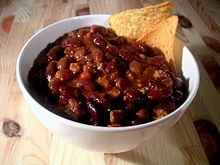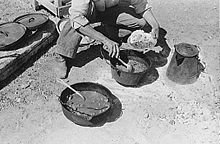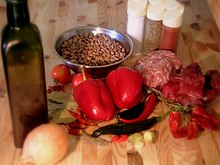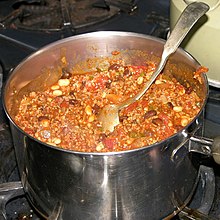Chili con carne

Chili con carne ( Nahuatl chilli , Spanish con carne "with meat") is the name of a spicy dish made from meat and chili peppers .
Neither the origin of the name Chili con Carne nor that of an original recipe has been clearly established, it is probably in the south of North America . Today it is not included in Mexican cuisine , but in Tex-Mex cuisine . As with numerous other dishes, the original origin, the right ingredients and the spelling are debated.
history
It is not known where the dish was first cooked. The US states of Texas and New Mexico as well as Arizona claim that the origin of the chilli lies in their area. There are many stories about the original recipe. On the one hand it is said that the US Army prepared chili for the first time , in other stories its origin is attributed to Native Americans , Greek, Irish, Spanish or Chinese immigrants.
What is clear, however, is the influence of Mexican cuisine , in which different types of chili peppers are often combined in order to achieve unusual flavors. One example is the seasoning sauce Mole , which is used for the typical Mexican dish Mole Poblano (literally “Sauce from Puebla”) - a spicy chocolate sauce that is traditionally served with turkey and chicken, but also with pork and fish.
One possible origin of this dish is believed to be a preservation method known to the North American Indians as pemmican , which is now used in a similar way in the Caribbean under the name of jerk . Meat is dried over moderate heat with a mixture of hot spices, salt and fat, so it can be kept for a long time. This method was used until the mid-19th century to obtain provisions for long journeys across America. The meat preserved in this way was then cooked over the fire with some water and other possible ingredients (such as flour , corn flour or beans) to make a kind of thick soup.
The most ancient legend has it that the first recipe for chili appeared to a Spanish nun during a trance-like dream in the early 17th century . According to another story, chili was introduced into Texas prisons because both chili peppers and beef were among the cheapest foods available, making the dish suitable as prison food.
One of the oldest published chilli recipes is from Mrs. Owens' Cook Book (1880), another recipe can be found in the Manual for Army Cooks (War Department Document # 18) (1896). Other, older references to a chilli-like dish give neither the name nor the exact method of preparation, but it can be assumed that the origin is a few decades before the publications mentioned.
The dish is particularly popular among the Tejanos , Texans of Mexican origin. Most tejanos lived on the poverty line, so chili con carne was a welcome addition to the menu for them: all the ingredients required are cheap or can even be grown at home, the dish can be easily prepared in large quantities and is nutritious.
"Chili" and "Chile"
The spelling chili con carne or simply chili , which is mostly used in the USA, is mostly used as chili con carne or chili in Germany. The pepperoni pod is in the United States mostly as chile pepper called, which is geared to the Mexican-Spanish origin of the word. Only in a few states in the southwest of the USA is the term chile used both for the fruit and for the dish made from it. Texas is an exception, as the spelling chili is seen and defended as the only correct one.
In Mexico, peppers are called chile . The Spanish pronunciation of the word Chile is [ ˈtʃile ], roughly the same as the German pronunciation of the country Chile , but with a slightly shorter i . The Mexican-Spanish term chile is derived from the name for hot peppers in the Nahuatl language family, which was and is spoken by parts of the Aztec indigenous people in Mexico. The correct pronunciation ([ ˈtʃɪlɪ ]) of the Nahuatl term is roughly represented by the spelling chilli .
The US spelling chili for the dish may be derived from the US pronunciation of the Mexican-Spanish term chile , but it could also be related to the correct pronunciation of the Nahuatl term.
Etymologically , the term has no connection with the country name Chile , which is derived from the Quechua language spoken in the Inca Empire . There, peppers are referred to as Ají . The country itself, however, is also called chili in French, or earlier also in German , as in Heinrich von Kleist's story The Earthquake in Chili .
The spelling Chilli to designate the pepper or the dish, which is occasionally also found in Germany, is mainly used in Great Britain and Australia . In the USA, this spelling is often used in connection with the state of Illinois , as the similar word components are intended to underline the origin of the chilli cooked there .
Chili as a ready meal
The first attempt at canning and selling chili con carne was made by William G. Tobin of San Antonio , Texas , between 1877 and 1882. In 1881 he signed a contract with the US government for the supply of canned chilli to the US Army and Navy. A few days after the first bottling factory he had planned was put into operation, he died on July 28, 1884 without this project being continued.
The success story of Wolf Brand Chili , a brand that is still popular in the United States began in 1895 when Lyman T. Davis started at its own recipe made chili in his hometown of Corsicana ( Texas sell). After initially trying to sell his chilli dried in briquette form, he began in 1921 to fill chilli in cans. In 1924, however, he sold his company after oil was found on his farm . Today Wolf Brand Chili is part of ConAgra Foods , Inc.
Another well-known and still widespread mix of chilli and spices was developed by Wick Fowler under the name Two Alarm Chili Kit and has been sold since 1964. Wick Fowler, actually a journalist and war correspondent, was one of the participants in the first cookoff . There he prepared his Two Alarm Chili , which was based on this spice mixture.
Texas: The Chili State
Even if the origins of the chilli are unclear, it is certain that Texas developed very quickly to the center of chilli culture. The simple and cheap dish, easily cooked with ingredients that were ubiquitous, gained popularity in the late 19th and early 20th centuries and quickly became a fixture in the state's culinary culture.
One place in Texas appears again and again in the stories about Chili con Carne : San Antonio , around 1880 a city characterized by the military, railroad and cattle breeding, whose residents, visitors and travelers relied on a quick, cheap meal. In public places such as the market square or in front of the military facilities, more and more mobile stalls appeared selling boiled beans, enchiladas , tortillas and, of course, chili con carne . The operators, known as Chili Queen , mostly of Mexican origin, shaped the cityscape of this time with their eye-catching clothes and the vans illuminated with colorful lanterns. With a new regulation on hygiene in catering establishments from 1937, however, the history of the Chiliqueens ended. Those who did not have enough money to convert their business into a restaurant became unemployed. In 1939, the then mayor, Maury Maverick, ensured that street sales of the Chiliqueens could continue, but only for a short time, as the stalls were soon closed again with the start of the Second World War. Today in San Antonio the tradition of the Chiliqueens is remembered with an annual Return of the Chili Queens Festival as part of the Memorial Days in May.
Chili con Carne has officially been the State Dish of the State of Texas since 1977 . Several manufacturers of chilli con carne urged the Texas government to make this decision to underscore the court's relationship with Texas. The request submitted in 1984 by Congressman Manuel Lujan of New Mexico to also designate chili con carne as the national dish of the United States has not yet been accepted by Congress.
ingredients
Basic ingredients
The only common ingredients in all chili recipes are meat and chili peppers. But there are already big differences in the exact selection of these ingredients. You can choose to use minced meat or meat cut into cubes. It can be beef , game or pork . Combinations of different types of meat can be found just as often.
The selection of chilli varieties is just as diverse. Chiltepin , which is barely the size of a pea, which is probably also used in the original recipes , is popular, as are other local varieties such as jalapeño , ancho or pasilla . Habaneros are used less often because their typical fruity taste evaporates very quickly when cooked. In addition to fresh chilli peppers, dried chilli peppers and various chilli powders and sauces are also used.
The oregano and cumin spices that are typical of Tex-Mex cuisine are also used in most chili-con-carne recipes. In order to cook chili con carne as true to the original as possible, Mexican oregano can be used instead of oregano , which is common in Europe . This Central American herb is only distantly related to the oregano known here and has a similar but stronger taste.
Other flavor-determining ingredients that appear in almost every chilli recipe are onions and garlic , and more rarely coriander , bay leaves and pepper .
Beans are controversial as an ingredient. While a chili in Texas Style contains no beans, there are many other variations that pinto beans provide or black beans. A compromise is that you serve beans cooked separately with the chilli .
Historically, the use of beans can be justified by the fact that chili con carne has always been a poor man's food , and beans were cheaper than meat, but also contain protein.
Variations
Here are other possible ingredients:
- Tomatoes give chilli a firmer consistency, as they thicken quite a bit after being cooked for a long time.
- German recipes in particular often feature corn , one of the typical American types of grain that does not appear in original recipes .
- A liquid is chosen as the basis for a chili, which gives the dish the necessary basic taste. In addition to all variations of broth , wine , beer and cold coffee are also used in Europe .
- To round off the taste, sugar , honey , chocolate or cocoa are sometimes added shortly before the end of the cooking time . The last two ingredients give the dish a brown color.
However, despite much controversy about the recipe, there are some basic types that share certain properties. Some have a historical background and are closely linked to their areas of origin, others - especially newer variants - are the result of personal eating habits.
- A Texas style chilli does not contain any vegetables besides the (if possible whole, fresh or dried) chilli peppers. The meat is usually cut into cubes and comes from beef or pork, and occasionally game. The jailhouse chilli , which is cooked according to old recipes from Texas prisons, also falls under this category.
- Chili verde ( Green Chili ) and Red Chili are variations from New Mexico that are cooked with fresh green or red chillies. Usually they are more liquid than a Chili Texas Style .
- The Cincinnati style chilli forms a separate category . While chili was initially only popular in the southern United States, it was likely popularized in the northeast by Greek immigrants as well. In doing so, they adapted the recipe to Greek cooking habits, so that it is less hot and seasoned with spices such as cinnamon , allspice or nutmeg . Is served Cincinnati Chili mostly on pasta or as a sauce for hot dogs .
- Chili sin carne , vegetarian chili or chili non carne are names for vegetarian or vegan variants. The meat is either left out entirely or meat substitutes such as textured soy or tofu are used. Variants with soy are also known as chili con soy .
- The term salsa does not refer to a chilli in its own sense, but is used for almost all hot sauces of Latin American origin. In “Chili Cookoffs”, the freestyle category is usually referred to as salsa . Salsas come in different flavors and with varying ingredients. Salsas with avocados are known as guacamole .
Cooking competitions
overview
The so-called chilli cookoffs are popular folk festivals, but they are organized according to strict rules. Two competing associations organize these cooking competitions, and each association holds its own championship every year according to its rules. Officially, however, only the International Chili Society is allowed to speak of a world championship, as it is the holder of the rights to this term.
CASI cookoffs
The Chili Appreciation Society International was founded in 1951 as the Chili Appreciation Society with the aim of making Chili con Carne known not only as a dish, but also as a way of life. The first competition was held in 1967 as a promotional event for the book A Bowl of Red by Frank Tolbert in Terlingua place, a ghost town in Texas . The Texan Wick Fowler - an advocate of the Texas Style Chili without beans - competed against H. Allen Smith from New York, who prepared a chili with beans. A battle for prestige that ended in a draw.
Today the "CASI Cookoffs" are divided into different categories, starting with an open championship - the CASI sanctioned Cookoffs - in which the cooks can qualify for the next higher championship - the CASI Open Championships . Successful participation in the Open Championships is again necessary in order to be admitted to the international championship TICC (Terlingua International Chili Championship).
There is a strict set of rules for all cooking competitions; some of the most important rules for CASI cookoffs from the official rulebook:
- The competitions take place in the open air; Cooking in caravans or the like is not allowed.
- Each chef is only allowed to enter one chili per competition .
- The chilli must be cooked from scratch on the day of the competition . The meat must initially be raw and must not have been marinated.
- Fillers such as beans, pasta, rice or corn flour are not allowed.
- The chefs may have to try their own chilli if instructed , otherwise they will be disqualified.
- The winner is determined through a two to three-stage selection. Five to six jurors decide in the preliminary round and at least ten in the final round.
- The evaluation is based on the five criteria of aroma, consistency, red color, taste and aftertaste.
In addition to the actual cooking competitions, there are also the so-called Showman Championships , in which the most original appearance of a cooking team is awarded. Due to a dispute between Frank Tolbert and other members of the CASI about the participation of two Europeans in the championship in Terlingua, there has been another championship independent of the TICC since 1982. After a legal dispute over the name, this competition is now called The Original Viva Terlingua International Frank X Tolbert - Wick Fowler Memorial Championship Chili Cookoff.
ICS cookoffs
The International Chili Society was founded in 1974 . Due to existing and increasingly growing differences with CASI co-founder Frank Tolbert, the organization started its own chili championship in 1975. Much to the chagrin of the rival event, the ICS registered the term World Championship Chili Cookoff as a trademark. The ICS uses this fact to artificially lengthen its own history: The winners of the TICC from 1967 to 1974 appear in the ICS list of chilli world champions, even though they were organized by the CASI. Until 1991 the world championship took place in the Tropico Gold Mine near Rosamond ( California ) in the Mojave Desert - the only exception was 1980, when the Paramount Ranch in Agoura was the venue. In 1992 the World Cup took place in Rawhide, a wild west town near Scottsdale ( Arizona ), after which it moved to Reno ( Nevada ). There is also a qualification procedure for the ICS Cookoffs to be admitted to the World Cup. Participants in District , State and Regional Championships have to qualify.
The ICS rulebook distinguishes between three basic categories in which the participating chefs can compete:
- A Traditional chili is loud ICS rules any kind of meat or any combination of different meats, cooked with red chili peppers and other ingredients, with the exception of pasta and beans.
- According to ICS rules, chili verde is any type of meat or any combination of different types of meat, cooked with green chili peppers and other ingredients, with the exception of pasta and beans.
- Salsa is not subject to any regulations regarding ingredients, preparation or place of preparation.
Curiosities
- The southernmost Chili Cookoff takes place annually in the Antarctic .
- Chili con Carne is often sung about in songs. An English-language song that can often be found in the repertoire of barbershop listeners has a chili recipe as the text. There is another sung chili recipe in the repertoire of the Swedish a cappella band The Real Group . The Steve Miller Band sings in their song Hot Chili : “Hot chili is groovy, after a movie or watching TV. But when you order south of the border soon you see it's hotter than noon, it will melt your spoon "(for example:" Hot chili is great after a movie or while watching TV. But if you order it in Mexico , you will soon notice that it's hotter than the midday heat, it'll melt your spoon ”). The Austrian singer Kurt Ostbahn expresses it with: "So hate and so schoaf that i no long tram away" ("So hot and so hot that I dream of it for a long time"). The American punk rock band No Use for a Name released the album Leche con carne ("Milk with Meat") based on the court in 1995 .
- In the Simpsons episode 162 Homer's strange chilli trip (original: El Viaje Misterioso de Nuestro Jomer or The Mysterious Voyage of Homer ) part of the plot takes place on a “chilli cookoff”. Among others, Ned Flanders, Prof. Frink and Chief Wiggum present their recipes.
- In the US TV series Columbo , the eponymous inspector often and happily takes a portion of chilli in a dingy diner called Barney's Beanery in Los Angeles .
literature
- Jane Stern, Michael Stern: Chili Nation . Broadway Books, New York 1999, ISBN 0-7679-0263-7 (English)
- Frank X. Tolbert: A Bowl Of Red . With foreword, re-edited by Hallie Stillwell. A&M University Press, Texas 2001, ISBN 1-58544-209-7 (English)
Web links
- Chili Appreciation Society International (English)
- International Chili Society (English)
- The Great Chili Con Carne Project from Dave DeWitt's Dave's Pepper Pages (English) Archived version ( Memento from April 14, 2004 in the Internet Archive )
- History and Legends of Chili, Chili Con Carne from Linda Stradley's What's Cooking America? (English)
- The Chili Queens of San Antonio at npr.org (English)
Individual evidence
- ^ Manual for Army Cooks . (PDF; 77.3 MB) Commissary General of Subsistence, United States Government Printing Office, Washington 1896.
- ↑ Oxford dictionary (American English): chili con carne (Engl.)
- ↑ Duden: Chili con Carne
- ↑ Chili # 2 . In: duden.de
- ↑ Handbook of Texas Online: Fowler, Homer Thomas Wilson ( Archived version ( February 13, 2007 memento on the Internet Archive ), accessed January 24, 2009).
- ↑ Timothy Charles Lloyd: The Cincinnati Chili Culinary Complex . In: Western Folklore . tape 40 , no. 1 , January 1, 1981, pp. 28-40 , doi : 10.2307 / 1499846 , JSTOR : 1499846 .
-
^ JAT Pennington, TB Hernandez: Core foods of the US food supply . In: Food Additives & Contaminants . tape 19 , no. 3 , March 1, 2002, ISSN 0265-203X , p. 249 , doi : 10.1080 / 02652030110081164 , PMID 11837242 . · MW Orcutt, MK McMindes, H. Chu, IN Mueller, B. Bater, AL Orcutt: Textured Soy Protein Utilization in Meat and Meat Analog Products . In: Mian N. Riaz (Ed.): Soy Applications in Food . CRC Press , Boca Raton 2006, ISBN 978-0-8493-2981-4 , pp.
183 . Melanie Lukas, Holger Rohn, Michael Lettenmeier, Christa Liedtke, Klaus Wiesen: The nutritional footprint - integrated methodology using environmental and health indicators to indicate potential for absolute reduction of natural resource use in the field of food and nutrition . In: Journal of Cleaner Production . tape
132 , September 20, 2016, ISSN 0959-6526 , p. 165 , doi : 10.1016 / j.jclepro.2015.02.070 . · Maggie Green: The Kentucky Fresh Cookbook . University Press of Kentucky , Lexington (Kentucky) 2011, ISBN 978-0-8131-3378-2 , pp.
289 . · Martin Kintrup: 1 pot - 50 dishes . 1st edition. Gräfe and Unzer , Munich 2011, ISBN 978-3-8338-2256-8 , pp.
54 . - ↑ a b Dave DeWitt: Cookoff Chilis, CASI-Style . In: The Great Chili Project . Archived version ( Memento of April 11, 2004 in the Internet Archive ), accessed January 24, 2009.
- ↑ Tolbert, pp. 71-76.
- ↑ Official CASI Rules . ( Memento of August 24, 2014 in the Internet Archive ) Chili.org
- ↑ Dave DeWitt: Cookoff Chilis, ICS-Style . In: The Great Chili Project . ( Archived version ( Memento of April 11, 2004 in the Internet Archive ), accessed January 24, 2009).
- ^ ICS Official Contestant Rules & Regulations . ( Memento from March 12, 2015 in the Internet Archive ) ChiliCookoff.com
- ^ Life in Antarctica . on www.antarcticaonline.com . Retrieved May 28, 2011.
- ^ Warren Martyn, Adrian Wood: El Viaje Misterioso del Nuestro Homer. BBC Episode Guide The Simpsons ; Retrieved January 24, 2009.



